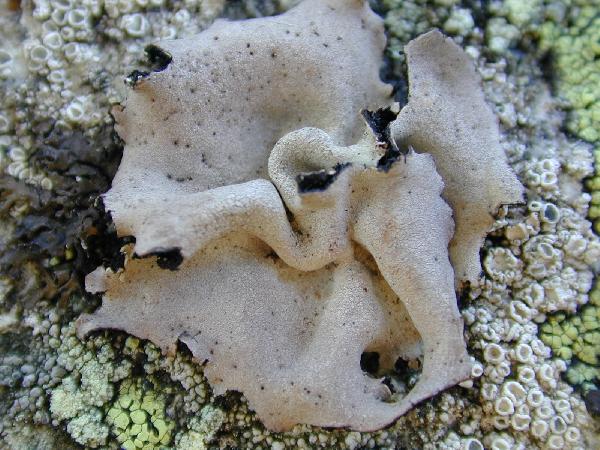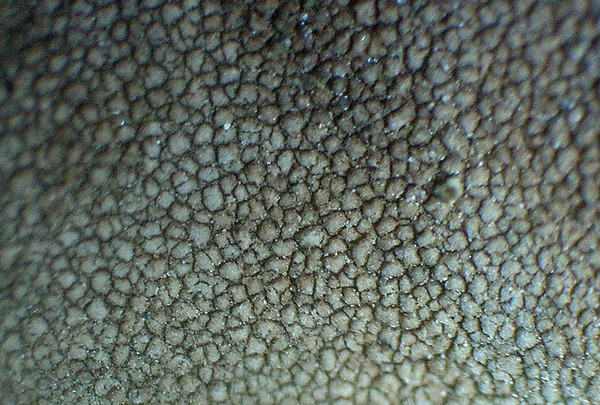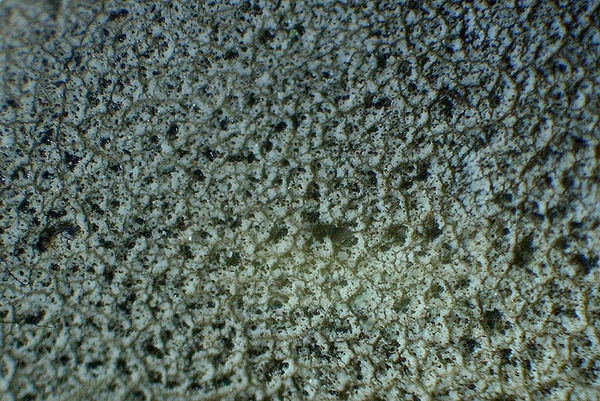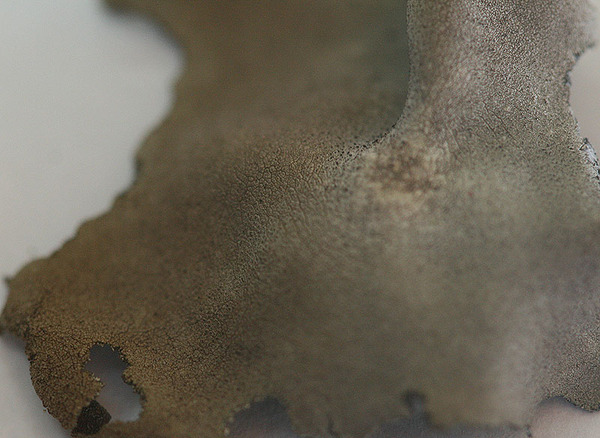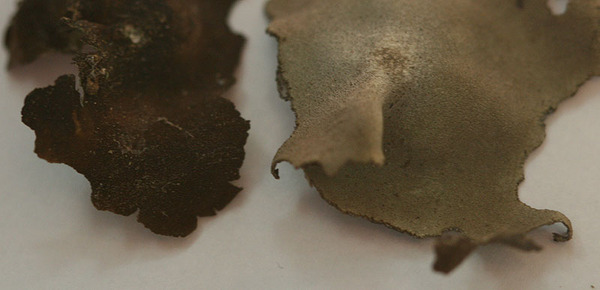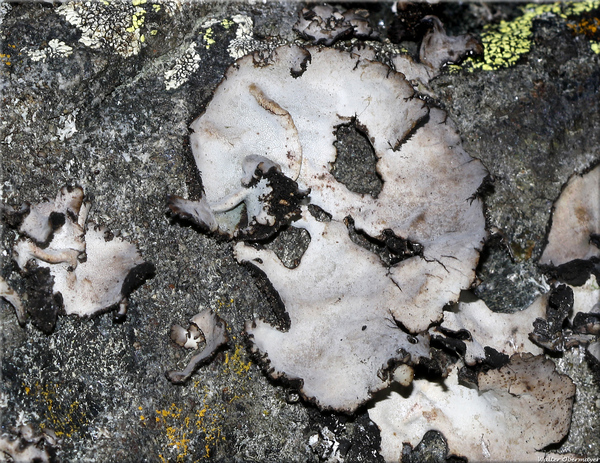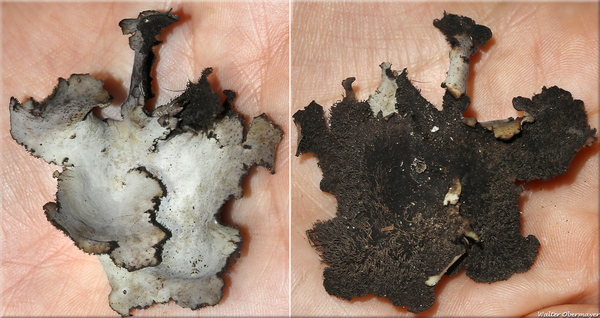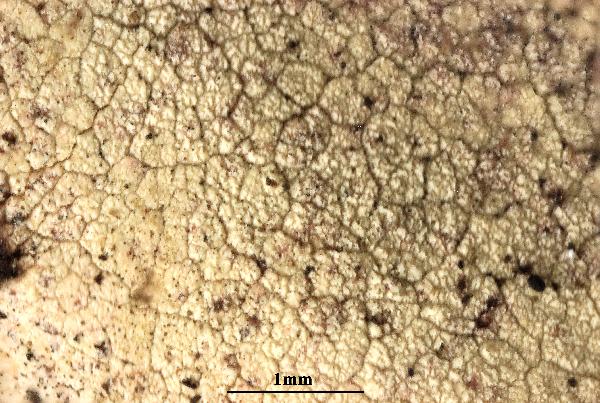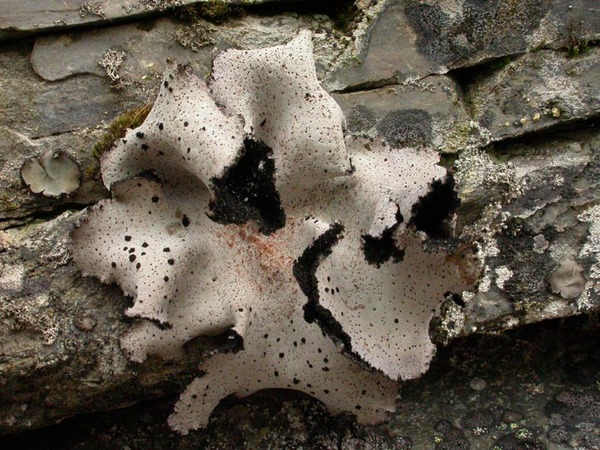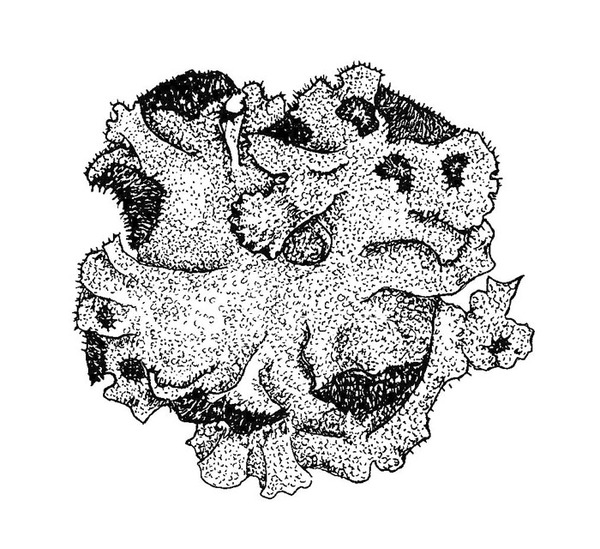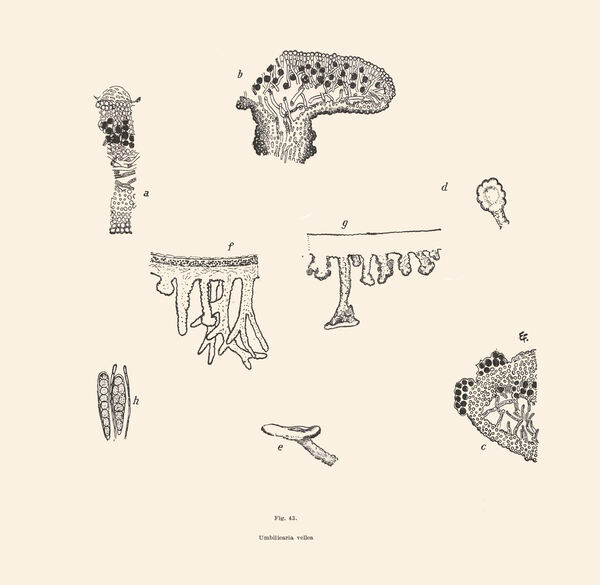Umbilicaria vellea (L.) Ach.
K. Vetensk-Acad. Nya Handl., 15: 101, 1794. Basionym: Lichen velleus L. - Sp. Pl., 2: 1150, 1753.
Synonyms: Gyrophora cirrhosa (Hoffm.) Flörke non auct.; Gyrophora vellea (L.) Ach.; Gyrophora vellerea Nyl.; Umbilicaria cirrhosa Hoffm. non auct.; Umbilicaria spodochroa auct. p.p. non Hoffm.
Distribution: N - Frl (TSB 16540), Ven, TAA (Nascimbene & al. 2022), Lomb, Piem (Morisi & Sereno 1995, Isocrono & al. 2003, 2004), VA (Piervittori & Isocrono 1997, 1999), Emil, Lig. C - Tosc, Sar (TSB 7288). S - Bas (Potenza & al. 2014), Cal (Puntillo 1996).
Description: Thallus foliose-umbilicate, heteromerous, dorsiventral, mainly monophyllous, rigid, 4-8(-20) cm wide, 0.2-0.3(-0.4) mm thick, with entire to incised, slightly up- or down-tuned margins, attached by a thick, dark, more or less central holdfast. Upper surface pale brown to greyish violet, dull, smooth to scabrous, distinctly rimose with dark cracks, slightly raised over the umbilicus and with a few trabeculatefolds. Lower surface black, more or less scabrous, with a dense felt of rhizinomorphs except around the umbilicus and in the marginal zone. Rhizinomorphs of two types: black, short, stout and ball-tipped, immixed with others which are pale brown to ivory white, cylindrical, simple or branched. Thalloconidia large, 22-40 x 31-60 µm, multi-septate, 50-300-celled, dark brown to black, irregular, arising both on the lower cortex and in clusters on the tips of rhizinomorphs. Upper cortex palisade-plectenchymatous, 11-30 µm thick; medulla white, dense, 45-130 µm thick; lower cortex brown, scleroplectenchymatous, 20-60 µm thick. Apothecia rare, gyrodisc, black, to 3 mm across. Epithecium black-brown; hymenium colourless; paraphyses mostly simple, with enlarged apical cells; hypothecium brown. Asci 8-spored, clavate, thick-walled, with an amyloid apical dome, Umbilicaria-type. Ascospores 1-celled, hyaline, broadly ellipsoid, 9-12 x 6-8 µm. Photobiont chlorococcoid. Spot tests: medulla K-, C+ red, KC+ red, P-. Chemistry: medulla with gyrophoric, lecanoric, hiascic and umbilicaric acids. Note: an arctic-alpine, probably circumpolar lichen found on steeply inclined to vertical, exposed surfaces of siliceous rocks with some water seepage, especially along fissures, with optimum above treeline. Earlier records from Marche and Latium (see Nimis 1993: 721) plus the record from Umbria by Ravera & al. (2004), being dubious, are not accepted here.
Growth form: Foliose, umbilicate
Substrata: rocks
Photobiont: green algae other than Trentepohlia
Reproductive strategy: mainly asexual, by conidia and thalloconidia
On otherwise dry surfaces with short periods of water seepage after rain
Commonnes-rarity: (info)
Alpine belt: rather rare
Subalpine belt: very rare
Oromediterranean belt: extremely rare
Montane belt: absent
Submediterranean belt: absent
Padanian area: absent
Humid submediterranean belt: absent
Humid mediterranean belt: absent
Dry mediterranean belt: absent
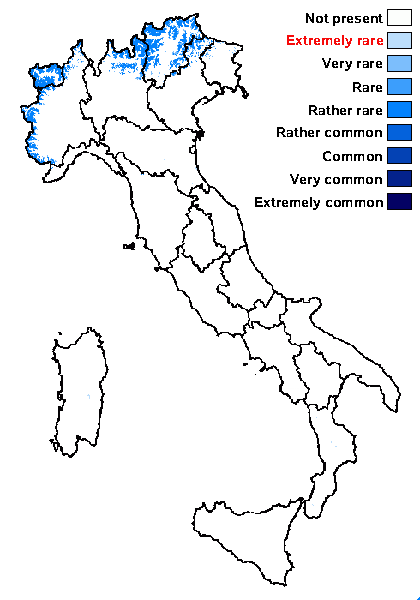
Predictive model
Herbarium samples


P.L. Nimis; Owner: Department of Life Sciences, University of Trieste
Herbarium: TSB (16530)
2001/12/05
detail of lower surface
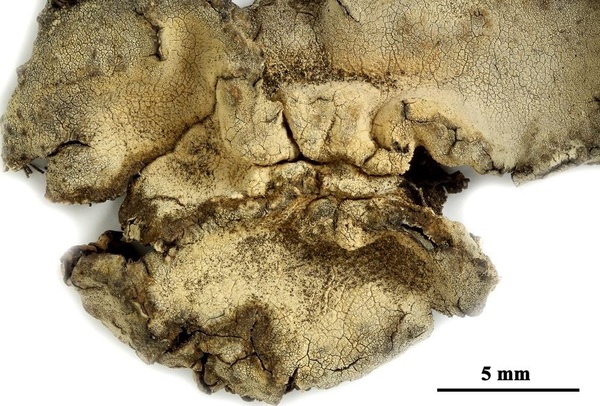

Felix Schumm - CC BY-SA 4.0
[LIAF_15], Afghanistan, Prov. Kabul, Paghman-Gebirge, oberhalb des Ortes Paghman, an der Talgabelung Chap-Darrah und Rast-Darrah, 68°56’ E, 34°37’ N, ca. 2550 m, Silikatfelsen-Felswände, meist Nexponiert. Leg. D. Podlech (Pod 58/2), 17.05.1977. LICHENOTHECA AFGHANICA NR. 15.
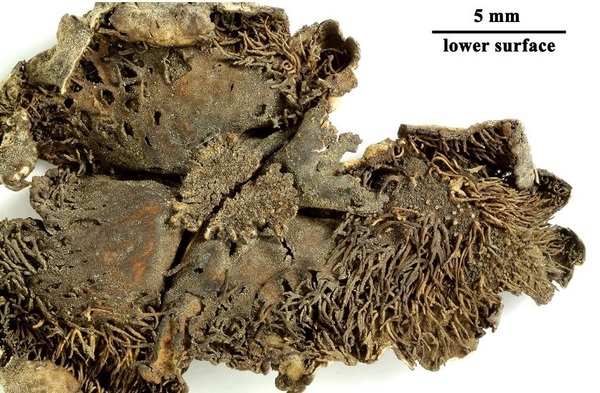

Felix Schumm - CC BY-SA 4.0
[LIAF_15], Afghanistan, Prov. Kabul, Paghman-Gebirge, oberhalb des Ortes Paghman, an der Talgabelung Chap-Darrah und Rast-Darrah, 68°56’ E, 34°37’ N, ca. 2550 m, Silikatfelsen-Felswände, meist Nexponiert. Leg. D. Podlech (Pod 58/2), 17.05.1977. LICHENOTHECA AFGHANICA NR. 15.


Felix Schumm - CC BY-SA 4.0
[LIAF_29], Afghanistan, Prov. Kabul, Paghman-Gebirge, oberhalb des Ortes Paghman, an der Talgabelung Chap-Darrah und Rast-Darrah, 68°56’ E, 34°37’ N, ca. 2550 m, steile Silikatfelsen, N-exponiert. Leg. M. Steiner (Ste 36/2, 37/2, 59/4), 30.05., 21.06.1970. LICHENOTHECA AFGHANICA NR. 29.
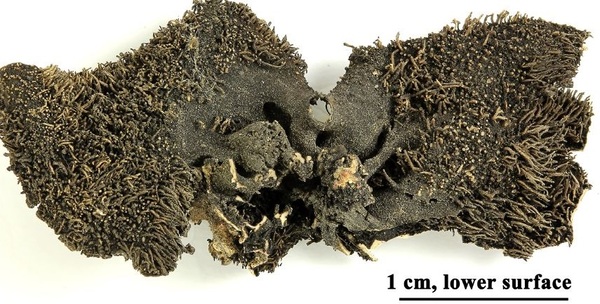

Felix Schumm - CC BY-SA 4.0
[LIAF_29], Afghanistan, Prov. Kabul, Paghman-Gebirge, oberhalb des Ortes Paghman, an der Talgabelung Chap-Darrah und Rast-Darrah, 68°56’ E, 34°37’ N, ca. 2550 m, steile Silikatfelsen, N-exponiert. Leg. M. Steiner (Ste 36/2, 37/2, 59/4), 30.05., 21.06.1970. LICHENOTHECA AFGHANICA NR. 29.
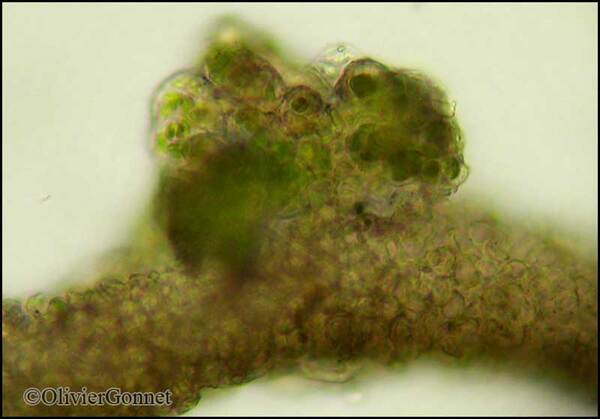
Courtesy Danièle et Olivier Gonnet - Source: https://www.afl-lichenologie.fr/Photos_AFL/Photos_AFL_U/Textes_U/Umbilicaria_vellea.htm
France, session AFL en Haute-Ubaye - Alpes-de-Haute-Provence
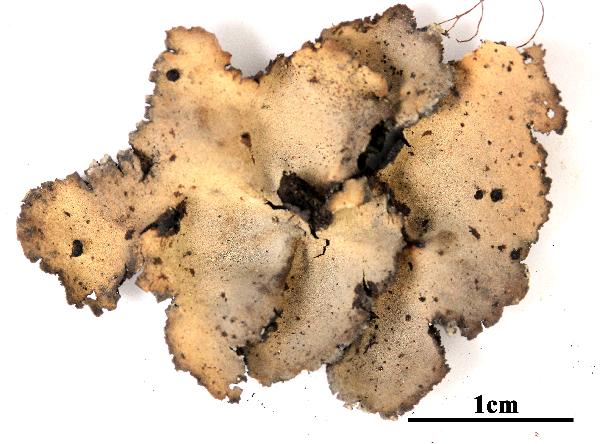

Felix Schumm - CC BY 4.0
[KU600], Japan. Honshu. Prov. Shinano: Mt. Ohyama, near Jyumonji
Pass, Minamisaku-gun. On rocks (granite), 2200 m.Leg. H. Shibuichi
(mo. 5854) & K. Yoshida, 12.07.1079, det. H. Kashiwadani. EX S.
KUROKAWA AND H. KASHIWADANI: LICHENES RARIORES ET CRITICI
EXSICCATI NR. 600.
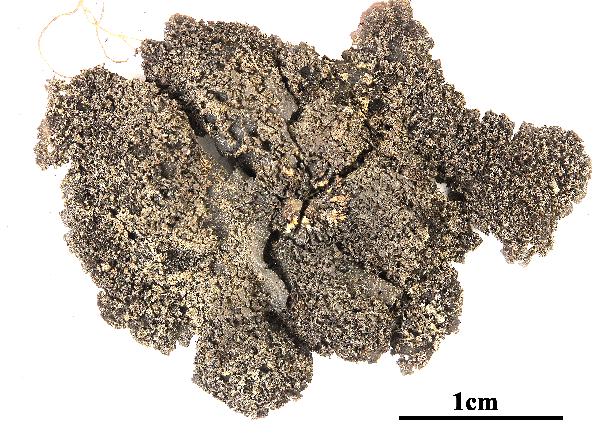

Felix Schumm - CC BY 4.0
[KU600], Japan. Honshu. Prov. Shinano: Mt. Ohyama, near Jyumonji
Pass, Minamisaku-gun. On rocks (granite), 2200 m.Leg. H. Shibuichi
(mo. 5854) & K. Yoshida, 12.07.1079, det. H. Kashiwadani. EX S.
KUROKAWA AND H. KASHIWADANI: LICHENES RARIORES ET CRITICI
EXSICCATI NR. 600.


Felix Schumm - CC BY 4.0
[LIAF_15], Afghanistan, Prov. Kabul, Paghman-Gebirge, oberhalb des
Ortes Paghman, an der Talgabelung Chap-Darrah und Rast-Darrah,
68°56’ E, 34°37’ N, ca. 2550 m, Silikatfelsen-Felswände, meist Nexponiert.
Leg. D. Podlech (Pod 58/2), 17.05.1977. LICHENOTHECA
AFGHANICA NR. 15.
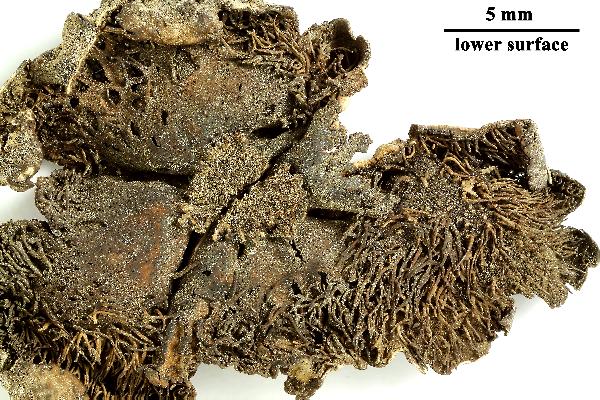

Felix Schumm - CC BY 4.0
[LIAF_15], Afghanistan, Prov. Kabul, Paghman-Gebirge, oberhalb des
Ortes Paghman, an der Talgabelung Chap-Darrah und Rast-Darrah,
68°56’ E, 34°37’ N, ca. 2550 m, Silikatfelsen-Felswände, meist Nexponiert.
Leg. D. Podlech (Pod 58/2), 17.05.1977. LICHENOTHECA
AFGHANICA NR. 15.
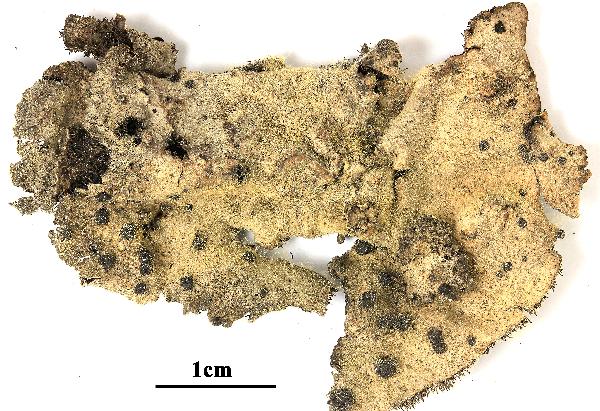

Felix Schumm - CC BY 4.0
[VZ1413], U.R. S. S. Armenia. Distr. Krasnoselsk, Caucasus Minor,
iugum montium Sevanskij chrebet dictum, supra lacum Sevan prope
pagum Cavagjukh, 2500 m. Ad saxa silicea. Leg. A. V zda, 24.05.1976.
Ex A. V zda: Lichenes Selecti Exsiccati Nr. 1413.
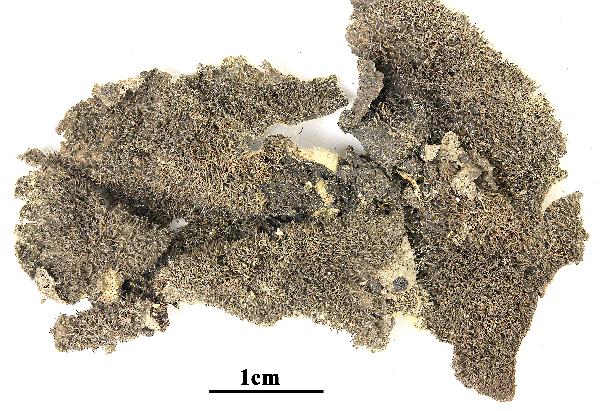

Felix Schumm - CC BY 4.0
[VZ1413], U.R. S. S. Armenia. Distr. Krasnoselsk, Caucasus Minor,
iugum montium Sevanskij chrebet dictum, supra lacum Sevan prope
pagum Cavagjukh, 2500 m. Ad saxa silicea. Leg. A. V zda, 24.05.1976.
Ex A. V zda: Lichenes Selecti Exsiccati Nr. 1413.
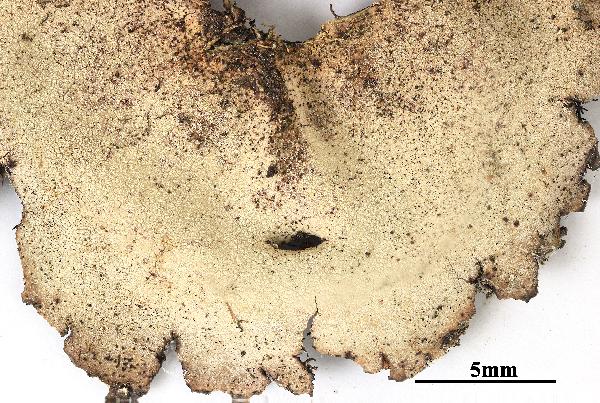

Felix Schumm - CC BY 4.0
[VZR180], Italia, Brescia. Alpi bresciani, Adamello, Val di Fumo, in
ripa lacus Lago di Malga Bissina, 1800 m. In rupibus graniticis. Leg. A.
V zda & F. Ceni, 29.07.1995. EX A. V ZDA: LICHENES RARIORES
EXSICCATI NR. 190.
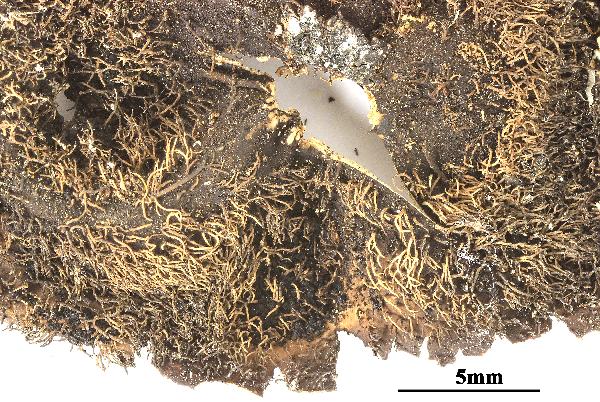

Felix Schumm - CC BY 4.0
[VZR180], Italia, Brescia. Alpi bresciani, Adamello, Val di Fumo, in
ripa lacus Lago di Malga Bissina, 1800 m. In rupibus graniticis. Leg. A.
V zda & F. Ceni, 29.07.1995. EX A. V ZDA: LICHENES RARIORES
EXSICCATI NR. 190.
Growth form: Foliose, umbilicate
Substrata: rocks
Photobiont: green algae other than Trentepohlia
Reproductive strategy: mainly asexual, by conidia and thalloconidia
On otherwise dry surfaces with short periods of water seepage after rain
Commonnes-rarity: (info)
Alpine belt: rather rare
Subalpine belt: very rare
Oromediterranean belt: extremely rare
Montane belt: absent
Submediterranean belt: absent
Padanian area: absent
Humid submediterranean belt: absent
Humid mediterranean belt: absent
Dry mediterranean belt: absent

Predictive model
| Herbarium samples |


P.L. Nimis; Owner: Department of Life Sciences, University of Trieste
Herbarium: TSB (16530)
2001/12/05
detail of lower surface


Felix Schumm - CC BY-SA 4.0
[LIAF_15], Afghanistan, Prov. Kabul, Paghman-Gebirge, oberhalb des Ortes Paghman, an der Talgabelung Chap-Darrah und Rast-Darrah, 68°56’ E, 34°37’ N, ca. 2550 m, Silikatfelsen-Felswände, meist Nexponiert. Leg. D. Podlech (Pod 58/2), 17.05.1977. LICHENOTHECA AFGHANICA NR. 15.


Felix Schumm - CC BY-SA 4.0
[LIAF_15], Afghanistan, Prov. Kabul, Paghman-Gebirge, oberhalb des Ortes Paghman, an der Talgabelung Chap-Darrah und Rast-Darrah, 68°56’ E, 34°37’ N, ca. 2550 m, Silikatfelsen-Felswände, meist Nexponiert. Leg. D. Podlech (Pod 58/2), 17.05.1977. LICHENOTHECA AFGHANICA NR. 15.


Felix Schumm - CC BY-SA 4.0
[LIAF_29], Afghanistan, Prov. Kabul, Paghman-Gebirge, oberhalb des Ortes Paghman, an der Talgabelung Chap-Darrah und Rast-Darrah, 68°56’ E, 34°37’ N, ca. 2550 m, steile Silikatfelsen, N-exponiert. Leg. M. Steiner (Ste 36/2, 37/2, 59/4), 30.05., 21.06.1970. LICHENOTHECA AFGHANICA NR. 29.


Felix Schumm - CC BY-SA 4.0
[LIAF_29], Afghanistan, Prov. Kabul, Paghman-Gebirge, oberhalb des Ortes Paghman, an der Talgabelung Chap-Darrah und Rast-Darrah, 68°56’ E, 34°37’ N, ca. 2550 m, steile Silikatfelsen, N-exponiert. Leg. M. Steiner (Ste 36/2, 37/2, 59/4), 30.05., 21.06.1970. LICHENOTHECA AFGHANICA NR. 29.

Courtesy Danièle et Olivier Gonnet - Source: https://www.afl-lichenologie.fr/Photos_AFL/Photos_AFL_U/Textes_U/Umbilicaria_vellea.htm
France, session AFL en Haute-Ubaye - Alpes-de-Haute-Provence


Felix Schumm - CC BY 4.0
[KU600], Japan. Honshu. Prov. Shinano: Mt. Ohyama, near Jyumonji Pass, Minamisaku-gun. On rocks (granite), 2200 m.Leg. H. Shibuichi (mo. 5854) & K. Yoshida, 12.07.1079, det. H. Kashiwadani. EX S. KUROKAWA AND H. KASHIWADANI: LICHENES RARIORES ET CRITICI EXSICCATI NR. 600.


Felix Schumm - CC BY 4.0
[KU600], Japan. Honshu. Prov. Shinano: Mt. Ohyama, near Jyumonji Pass, Minamisaku-gun. On rocks (granite), 2200 m.Leg. H. Shibuichi (mo. 5854) & K. Yoshida, 12.07.1079, det. H. Kashiwadani. EX S. KUROKAWA AND H. KASHIWADANI: LICHENES RARIORES ET CRITICI EXSICCATI NR. 600.


Felix Schumm - CC BY 4.0
[LIAF_15], Afghanistan, Prov. Kabul, Paghman-Gebirge, oberhalb des Ortes Paghman, an der Talgabelung Chap-Darrah und Rast-Darrah, 68°56’ E, 34°37’ N, ca. 2550 m, Silikatfelsen-Felswände, meist Nexponiert. Leg. D. Podlech (Pod 58/2), 17.05.1977. LICHENOTHECA AFGHANICA NR. 15.


Felix Schumm - CC BY 4.0
[LIAF_15], Afghanistan, Prov. Kabul, Paghman-Gebirge, oberhalb des Ortes Paghman, an der Talgabelung Chap-Darrah und Rast-Darrah, 68°56’ E, 34°37’ N, ca. 2550 m, Silikatfelsen-Felswände, meist Nexponiert. Leg. D. Podlech (Pod 58/2), 17.05.1977. LICHENOTHECA AFGHANICA NR. 15.


Felix Schumm - CC BY 4.0
[VZ1413], U.R. S. S. Armenia. Distr. Krasnoselsk, Caucasus Minor, iugum montium Sevanskij chrebet dictum, supra lacum Sevan prope pagum Cavagjukh, 2500 m. Ad saxa silicea. Leg. A. V zda, 24.05.1976. Ex A. V zda: Lichenes Selecti Exsiccati Nr. 1413.


Felix Schumm - CC BY 4.0
[VZ1413], U.R. S. S. Armenia. Distr. Krasnoselsk, Caucasus Minor, iugum montium Sevanskij chrebet dictum, supra lacum Sevan prope pagum Cavagjukh, 2500 m. Ad saxa silicea. Leg. A. V zda, 24.05.1976. Ex A. V zda: Lichenes Selecti Exsiccati Nr. 1413.


Felix Schumm - CC BY 4.0
[VZR180], Italia, Brescia. Alpi bresciani, Adamello, Val di Fumo, in ripa lacus Lago di Malga Bissina, 1800 m. In rupibus graniticis. Leg. A. V zda & F. Ceni, 29.07.1995. EX A. V ZDA: LICHENES RARIORES EXSICCATI NR. 190.


 INDEX FUNGORUM
INDEX FUNGORUM
 GBIF
GBIF
 DOLICHENS
DOLICHENS
